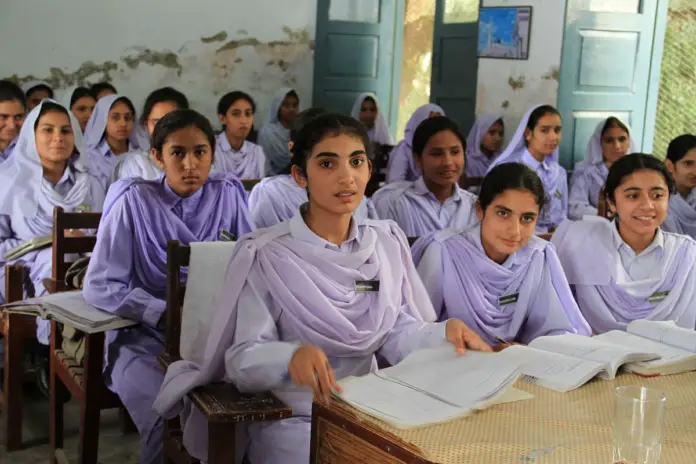Since 1967, International Literacy Day (ILD) celebrations have taken place annually around the world to remind the public of the importance of literacy as a matter of dignity and human rights, and to advance the literacy agenda towards a more literate and sustainable society. Despite progress made, literacy challenges persist with 771 million illiterate people around the world, most of whom are women, who still lack basic reading and writing skills and are faced with increased vulnerability.
Rapidly changing global context took a new meaning over the past years, hampering the progress of global literacy efforts. In the aftermath of the pandemic, nearly 24 million learners might never return to formal education, out of which, 11 million are projected to be girls and young women around the world. To ensure no one is left behind, we need to enrich and transform the existing learning spaces through an integrated approach and enable literacy learning in the perspective of lifelong learning.
This year’s International Literacy Day will be celebrated worldwide under the theme, “Transforming Literacy Learning Spaces” and will be an opportunity to rethink the fundamental importance of literacy learning spaces to build resilience and ensure quality, equitable, and inclusive education for all.
With the rise in extreme temperatures, massive loss of biodiversity, automation and recent technological development and the accompanying widening digital divide, pandemic diseases, violent political mobilization, impact of conflicts, forced displacement, democratic backsliding, and backlash against women’s rights, among other harsh realities our world faces today, hampering the progress of global literacy efforts.
Furthermore, a humanitarian crisis such as those in Afghanistan, Yemen, and in Ukraine are also crises in education, with millions fleeing the war-torn countries. According to the UN Migration Agency, over 700,000 Afghans were forced to leave, adding to the existing 5.5 million people displaced over past years. In Ukraine, aside from the 7.1 million people displaced by the war, more than 2,000 schools were damaged and more than 200 destroyed, impacting the learners in Ukraine for decades to come. In 2020, there were 771 million illiterate people around the world, two-thirds of whom were women, lacking basic reading and writing skills, and are faced with increased vulnerability in managing their health, work, and life overall. Although the global literacy rate is seeing an increasing trend over the past 50 years, 85.60% in 2015 and 86.68% in 2020, the averages of literacy rates are not representative of the substantive differences among various vulnerable groups based on their gender and geographical location, as indicated in the 2021 Annual Global Education data released by the UNESCO Institute for Statistics (UIS). These figures indicate the enormous task ahead for governments and partners to not only build back better but also to take a giant step forward in achieving the Sustainable Development Goals, especially Target 4.6 in ensuring that all youth and adults achieve literacy and numeracy by 2030.
Literacy learning systems and spaces are to be resilient in order to withstand the unprecedented realities ahead of us. To confront the immediate needs of changing global contexts, especially during COVID-19, global, national, and local governments had an almost universal response, aimed at the continuation of formal basic and higher education, and switched to complete or partial digital literacy learning spaces. However, for education to continue acting as an active medium of change, it needs to address the inclusivity and equality issues, that were further heightened due to the digital transformation of literacy learning spaces.
According to the report published by the International Commission on the Future of Education (2021), to transform the future, it is inevitable for the global communities and national governments to address the disproportionate access to Information and Communication Technology (ICT), including access to basic resources, such as electricity and household internet, especially among the youth and adults from vulnerable groups facing intersectional disadvantages due to poverty, gender identities and sexual orientation, social status, ethnicity, language diversity, disabilities, and geographical location.
The upcoming response also needs to account for the implications of the re-opening of formal educational institutions, and that certain vulnerable groups of learners might never return to formal education. To ensure no one is left behind, we need to enrich and transform the existing learning spaces with a learner-centric approach that enables literacy learning from the perspective of lifelong learning. Transforming literacy learning spaces includes the physical environment, learning materials, and activities required to facilitate the creation of the space, while the socio-cultural environment, political environment, partnerships, and the assessment of literacy activities are crucial for the sustenance of these spaces. With an expanded definition of literacy, it is evident that literacy learning is occurring beyond traditional ‘school-classroom’ spaces such as in the workplace, community, family, library, and digital, to name a few informal and non-formal learning spaces. As per the UNESCO recommendations of the United Nations Transforming Education Summit, Thematic Action Track 2 on Learning and Skills for Life, Work, and sustainable development, the characteristics of youth and adult learners, their evolving needs for literacy learning such as flexibility, proximity, ease of access, and link with the labour market are guiding factors for the transformation of literacy learning spaces. The transformation of literacy learning spaces not only entails the management of physical facilities more sustainably but also comprises changes in the governance structure of the educational systems and institutions by allowing the outcomes of literacy learning from informal and non-formal settings to be recognized, validated, and accredited through flexible data-driven monitoring and evaluation processes.
During the pandemic, in some countries, technological advancement in literacy learning spaces ensured the continuation of learning for adults and youth around the world. Countries with existing technological infrastructure could adapt to digital and hybrid modes of learning whereas countries with low infrastructure were left behind. Nevertheless, the quality of education was compromised for all learners across all countries. An equitable, inclusive, and intergenerational approach to address learners’ learning, social, and emotional needs is crucial, especially for those at utmost risk due to compounded vulnerability in disruptive global contexts.
Policies and the following measures can and should leverage the development in literacy learning spaces, equally in formal, informal, and non-formal contexts, while adapting and transforming them to be safe, resilient, equitable, and inclusive in setting the stage for lifelong learning of youth and adults around the world. Although not limited to, there is an imperative need for countries in conflict, host countries receiving refugees from conflict regions, countries facing the devastating impact of climate change, countries accelerating the post-COVID-19 recovery, and for countries facing the consequences of rapidly changing world contexts, to leverage from the existing innovations among the countries, adapt to the ever-evolving learner needs of the youth and adults, and transform their literacy learning spaces. It allows the inclusion of marginalized groups, ensures learning continuity, enables learners to be active citizens, and progresses towards the notion of creating learning societies. Additionally, these learner-centric spaces by design may promote the literacy in local language and support the learners in becoming literate in their first language along with their literacy in national languages. As reinforced through the International Decade of Indigenous Languages (2022-2032) by the UN General Assembly, literacy learning spaces comprises of six basic elements: (1) literacy materials and activities, (2) physical environment, – the two elements that facilitate the creation of the literacy learning space, and (3) socio-cultural environment, (4) political environment, (5) assessment, and (6) partnerships- that facilitate the sustenance of these spaces.
Literacy is the ability to identify, understand, interpret, create, communicate and compute, using printed and written materials associated with varying contexts. Literacy involves a continuum of learning in enabling individuals to achieve their goals, to develop their knowledge and potential, and to participate fully in their community and wider society. Generally, literacy also encompasses numeracy, the ability to make simple arithmetic calculations. The concept of literacy can be distinguished from measures to quantify it, such as the literacy rate and functional literacy (UIS, 2017). International evidence from the Responses to Educational Disruption Survey (REDS) shows local languages as a key-driver for sustainability and retaining indigenous knowledge for fighting against climate change.
Evolution of digital literacy learning spaces:
For the success of any learner in the knowledge-based economy, proficiency in subject matter is less important than learning how to learn. ICT enabled learning both in high- and low-tech systems could be leveraged for designing and scaling innovative learning practices such as self-regulated learning for youth and adults and setting the stage for lifelong learning.
Adapt – beyond digital literacy learning spaces to ensure inclusive and equitable education for all: The sudden and massive shift to remote digital learning in response to COVID-19 presents itself as both an opportunity for innovation and a risk for furthering the existing digital learning disparities among the youth and adults around the world. The growing digital divide in terms of connectivity, infrastructure, and the ability to engage with technology in providing quality education for all, excluded at least one third of the learners from pursuing learning remotely, catalyzing the vicious inequality cycle. There are significant gaps in the inclusion of indigenous and ethnic minority individuals in the formal education systems given the linguistic and geographical barriers, along with factors such as racism, discrimination, and lack of cultural relevance. Policies and the following action need to adapt literacy learning spaces for all through gender responsive spaces, spaces for refugees, internally displaced people, and migrants, and spaces with low-tech or no-tech solutions for low-and middle-income countries.
Transforming – Connecting learning pathways through governance of literacy learning spaces: Historically, literacy learning for youth and adults is occurring outside of the formal education systems through non-formal and informal learning mechanisms such as workplaces, entrepreneurial experiences, families, gaming, social media, to name a few. Skills and knowledge gained by youth and adults through these systems activate career opportunities and enable their participation in society as active contributing-members rather than as passive-recipients of circumstances. Literacy learning spaces are transforming, and policies and strategies need to keep up with these transformations through targeted financing and by allowing systemic level recognition, validation, and accreditation of the informal and non-formal learning outcomes. Capturing these learning outcomes through monitoring and evaluation methodologies sensitive to informal and non-formal outcomes are essential for supporting the existing and future transformations in literacy learning spaces.
Through the celebration of International Literacy Day, Literacy Department calls on all actors in the field of education and beyond to re-think about Transforming Literacy Learning Spaces.
In order to improve the performance of Non-Formal Schools, the Punjab government has provided funds to the department to purchase the necessary teaching materials for these schools and the learners studying in them. However, more resources are required to achieve the target of literacy rate 85% by 2030.
The Department of Literacy and Non-Formal Basic Education is committed to promoting education in remote and underprivileged areas across Punjab by adopting the need based approaches following the UNESCO and other international standards. It can be hoped that in the coming time, the efforts of this department will bear fruit and there will be a clear reduction in illiteracy and out-of-school children from the province of Punjab.







